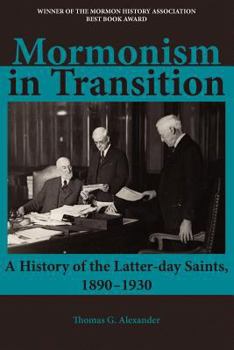Mormonism in Transition: A History of the Latter-day Saints, 1890-1930, 3rd ed.
Select Format
Select Condition 
Book Overview
A classic study of an influential American religion....Provides both the specialist in religion and the general reader with a thoughtful history of this complex religion. This description may be from another edition of this product.
Format:Paperback
Language:English
ISBN:1589581881
ISBN13:9781589581883
Release Date:June 2012
Publisher:Greg Kofford Books, Inc.
Length:412 Pages
Weight:1.36 lbs.
Dimensions:0.8" x 6.0" x 9.0"
Customer Reviews
3 ratings
Early 20th century Mormon history
Published by Thriftbooks.com User , 16 years ago
Mormonism in Transition describes the doctrine, practice, politics, and administration of the Salt Lake-based church between 1890 and 1930. In the decades that followed 1890, the Church renounced polygamy, abandoned its political party, and reduced its economic influence. Colonization came to an end and different practices were emphasized. By 1930, the Great Basin had become integrated into American capitalism and politics. None of these changes were instantaneous, and Thomas Alexander organizes his description of them topically. Years elapsed before the First Presidency convinced some church leaders to stop advocating polygamy. Church divestment of businesses was a slow process. Though the People's Party dissolved with Utah's statehood, not until Heber J. Grant's administration did endorsement of political candidates by church leaders become infrequent. Mormonism had transitioned to a new phase, though the description of 1930 practices shows more transitions have occurred since. This book is full of interesting statements, though often discussion of them is incomplete. Often I would read a fascinating sentence or paragraph, but Dr. Alexander's narrative would jump to another topic with nothing more than a footnote citing an archival source. Overall, the history is informative, but some of the most fascinating material was mentioned but not explored.
Fair and Interesting
Published by Thriftbooks.com User , 22 years ago
Anyone even slightly familiar with the beliefs, practices and culture of the LDS church in the time of Joseph Smith and Brigham Young and with LDS beliefs, practices and culture today will note a number of differences. It turns out that the period from 1900 to 1930, which is the subject of this book, was a watershed of cultural change for the Church. Before 1900, polygamy was a pillar of the social organization of the Church. Women were widely believed to acquire the priesthood authority of their husband through endowment and marriage. The Word of Wisdom was counsel, not systematically enforced -- and more than one early prophet thought that the most important element of the Word of Wisdom was the injunction not to eat meat! And so on. By 1930, in all these (and other) respects, the Church looked like the Church of today. Whatever you think of the changes (personally, and polygamy aside, I find the Church of the nineteenth century pretty seductive), the history is interesting. The book is well written, the authors' viewpoint objective (i.e., not hostile to or critical of the Church, and also not fawning salvation history). Add it to your Church History library today.
Winner of the Mormon History Association's Best Book Award
Published by Thriftbooks.com User , 25 years ago
My daughter bought this book for a church history class at BYU. When she was done with it, I began to browse, and got hooked. It provides an "institutional memory" for the interworkings of politics, social events, and the church at the turn of the century. That institutional memory applies amazingly well to the present time of rapid growth and change in the church.Thomas G. Alexander is a Lemuel Hardison Redd Jr. Professor of American History at Brigham Young University, and Stephen J. Stein is a Chancellors' Professor of Religious Studies at Indiana University.






